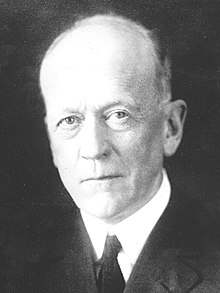
Back تشارلز دوليتل والكوت Arabic تشارلز دوليتل والكوت ARZ Charles Doolittle Walcott Czech Charles Walcott German Charles Doolittle Walcott Spanish Charles Doolittle Walcott Basque چارلز دولیتل والکوت Persian Charles Doolittle Walcott Finnish Charles Doolittle Walcott French צ'ארלס דוליטל וולקוט HE
Charles Doolittle Walcott | |
|---|---|
 | |
| 4th Secretary of the Smithsonian Institution | |
| In office 1907–1927 | |
| Preceded by | Samuel Pierpont Langley |
| Succeeded by | Charles Greeley Abbot |
| 3rd Director of the United States Geological Survey | |
| In office 1894–1907 | |
| Preceded by | John Wesley Powell |
| Succeeded by | George Otis Smith |
| 4th Director of the National Advisory Committee for Aeronautics | |
| In office 1920–1927 | |
| President | Calvin Coolidge |
| Preceded by | John R. Freeman |
| Succeeded by | Joseph Sweetman Ames |
| Personal details | |
| Born | March 31, 1850 New York Mills, New York, U.S. |
| Died | February 9, 1927 (aged 76) Washington, D.C., U.S. |
| Resting place | Rock Creek Cemetery Washington, D.C. |
| Spouses | Lura Ann Rust
(m. 1872; died 1876)Helena Breese Stevens
(m. 1888; died 1911) |
| Children | 4 |
| Signature | |
| Awards | Bigsby Medal (1895) Wollaston Medal (1918) Mary Clark Thompson Medal (1921) |
| Scientific career | |
| Fields | Paleontology |
| Institutions | Smithsonian Institution US Geological Survey |
| Author abbrev. (zoology) | Walcott |
Charles Doolittle Walcott (March 31, 1850 – February 9, 1927) was an American paleontologist, administrator of the Smithsonian Institution from 1907 to 1927, and director of the United States Geological Survey.[1][2] He is famous for his discovery in 1909 of well-preserved fossils, including some of the oldest soft-part imprints, in the Burgess Shale of British Columbia, Canada.
- ^ Gould, Stephen Jay (1989). "Chapter IV: Walcott's Vision and the Nature of History". Wonderful Life: The Burgess Shale and the Nature of History. New York & London: W. W. Norton & Company. pp. 240–291. ISBN 0-393-30700-X. LCCN 83-37469.
- ^ Motter, H. L., ed. (1912). "Walcott, Charles Doolittle". The International Who's Who: Who's Who in the World: a biographical dictionary of the world's most notable living men and women. New York City, U.S.A. p. 1059.